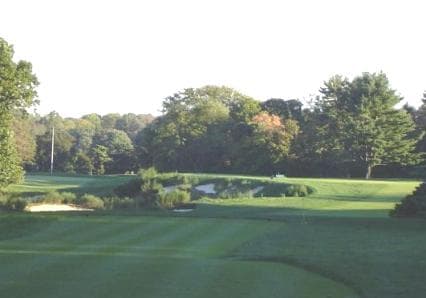Merion Golf Club, East Course

Merion Golf Club is a Private, 36 hole golf facility located in Ardmore, Pennsylvania, a suburb northwest of Philadelphia. The club has two courses,they are: The East Course, and The West Course.
The Merion Golf Club dates from 1896, when members of the Merion Cricket Club (founded in 1865) opened a golf course in Haverford, Pennsylvania. In 1910, the membership decided to build a new course and chose 32-year-old club member Hugh Wilson, a Scottish immigrant, to design it. Merion East opened in September 1912, and the original course was closed. The West Course, also designed by Wilson, opened in May 1914. The Merion Golf Club did not officially separate from the Merion Cricket Club until 1941.
Hugh Wilson had never designed a golf course, so he went on a seven-month trip to Scotland and England to study British courses. Several features of Merion East are derived from famous British courses, not the least of which are Merion's distinctive Scottish-style bunkers, which are now known as the "white faces of Merion". Wilson's layout covers only 126 acres of land, a very small area for a golf course. It was ranked seventh in Golf Magazines "Top100 Courses in the U.S" in 2006 and 2007. Jack Nicklaus has said of Merion East, "Acre for acre, it may be the best test of golf in the world."
Merion has held 17 United States Golf Association (USGA) championship tournaments, more than any other course. The first USGA tournament held at the East Course was the 1916 U.S. Amateur, won by Chick Evans. This was also the first time Bobby Jones appeared in a national championship; he was 14 years old. Jones would win his first U.S. Amateur in 1924, also held at Merion.
In 1930, the U.S. Amateur was again played at Merion. Earlier that year, Bobby Jones had won the British Amateur, British Open, and U.S. Open, so anticipation was high to see if he could complete the sweep of all four major championships of the time. Jones played well, cruising through to the final 36-hole match against Eugene Homans. A gallery of 9,000 was on hand for the start of the match and swelled to 18,000 by the afternoon round, forcing the competitors to be escorted to the tees and greens. Following the morning round Jones was ahead by seven holes, and when both players parred the 11th hole Jones had an 8 & 7 victory (8 holes ahead with seven to play). Searching for words to describe the unprecedented feat, Atlanta newsman O.B. Keeler used the term "Grand Slam", which has stuck ever since. Seven weeks after the tournament, Bobby Jones retired from competitive golf.
Merion's 1950 U.S. Open was also the site of Ben Hogan's comeback, after a head-on collision with a bus in 1949 which shattered his pelvis and nearly killed him. On the 72nd hole (and 36th of the day), in extreme pain and facing a shot of over 200 yards into the wind, Hogan needed a par to force a playoff. Hogan used a 1-iron to hit a superb shot which stopped on the distant green well within two-putt range, and made his par. Hogan then defeated Lloyd Mangrum and George Fazio in an 18-hole playoff the following day to win the tournament.
Following David Graham's win at the U.S. Open at Merion in 1981, it was felt by many that the relatively short course (about 6400 yards), small course area (which limits gallery size), and lack of grounds to hold corporate tents would preclude Merion from holding a major again. However, following some land acquisition nearby and lengthening of the course to 6,846 yards, many of these concerns appeared to be addressed. After successfully holding the 2005 U.S. Amateur, the USGA awarded the 2013 U.S. Open to Merion. Merion Golf Club was designated a National Historic Landmark in 1992.
On the East Course, all pins are topped with wicker baskets instead of the usual flags. Their origins are unknown, with the best guess being that Wilson saw something similar during his trip to Scotland and used the idea at Merion. One effect is that the baskets are visible no matter which way the wind is blowing - and also that they do not give the golfer any indication of wind direction at the green. They have been used since the course's opening, and are featured in the club's logo.